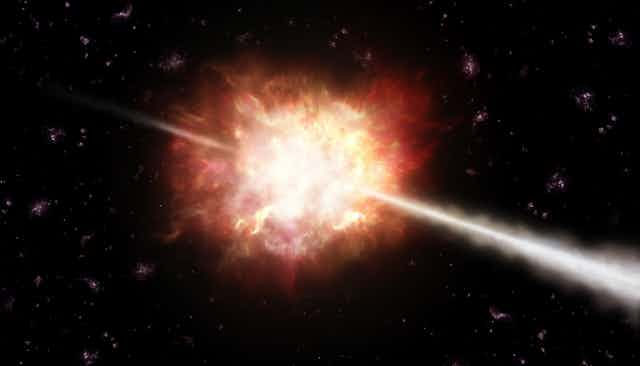Gamma ray bursts, intense explosions of light, are the brightest events ever observed in the universe – lasting no longer than seconds or minutes. Some are so luminous that they can be observed with the naked eye, such as the burst “GRB 080319B” discovered by NASA’s Swift GRB Explorer mission on March 19, 2008.
But despite the fact that they are so intense, scientists don’t really know what causes gamma ray bursts. There are even people who believe some of them might be messages sent from advanced alien civilisations. Now we have for the first time managed to recreate a mini version of a gamma ray burst in the laboratory – opening up a whole new way to investigate their properties. Our research is published in Physical Review Letters.
One idea for the origin of gamma ray bursts is that they are somehow emitted during the emission of jets of particles released by massive astrophysical objects, such as black holes. This makes gamma ray bursts extremely interesting to astrophysicists – their detailed study can unveil some key properties of the black holes they originate from.
The beams released by the black holes would be mostly composed of electrons and their “antimatter” companions, the positrons – all particle have antimatter counterparts that are exactly identical to themselves, only with opposite charge. These beams must have strong, self-generated magnetic fields. The rotation of these particles around the fields give off powerful bursts of gamma ray radiation. Or, at least, this is what our theories predict. But we don’t actually know how the fields would be generated.
Unfortunately, there are a couple of problems in studying these bursts. Not only do they last for short periods of time but, most problematically, they are originated in distant galaxies, sometimes even billion light years from Earth (imagine a one followed by 25 zeroes – this is basically what one billion light years is in metres).
That means you rely on looking at something unbelievably far away that happens at random, and lasts only for few seconds. It is a bit like understanding what a candle is made of, by only having glimpses of candles being lit up from time to time thousands of kilometres from you.
World’s most powerful laser
It has been recently proposed that the best way to work out how gamma ray bursts are produced would be by mimicking them in small-scale reproductions in the laboratory – reproducing a little source of these electron-positron beams and look at how they evolve when left on their own. Our group and our collaborators from the US, France, UK, and Sweden, recently succeeded in creating the first small-scale replica of this phenomenon by using one of the most intense lasers on Earth, the Gemini laser, hosted by the Rutherford Appleton Laboratory in the UK.
How intense is the most intense laser on Earth? Take all the solar power that hits the whole Earth and squeeze it into a few microns (basically the thickness of a human hair) and you have got the intensity of a typical laser shot in Gemini. Shooting this laser onto a complex target, we were able to release ultra-fast and dense copies of these astrophysical jets and make ultra-fast movies of how they behave. The scaling down of these experiments is dramatic: take a real jet that extends even for thousands of light years and compress it down to a few millimetres.
In our experiment, we were able to observe, for the first time, some of the key phenomena that play a major role in the generation of gamma ray bursts, such as the self-generation of magnetic fields that lasted for a long time. These were able to confirm some major theoretical predictions of the strength and distribution of these fields. In short, our experiment independently confirms that the models currently used to understand gamma ray bursts are on the right track.
The experiment is not only important for studying gamma ray bursts. Matter made only of electrons and positrons is an extremely peculiar state of matter. Normal matter on Earth is predominantly made of atoms: a heavy positive nucleus surrounded by clouds of light and negative electrons.

Due to the incredible difference in weight between these two components (the lightest nucleus weighs 1836 times the electron) almost all the phenomena we experience in our everyday life comes from the dynamics of electrons, which are much quicker in responding to any external input (light, other particles, magnetic fields, you name it) than nuclei. But in an electron-positron beam, both particles have exactly the same mass, meaning that this disparity in reaction times is completely obliterated. This brings to a quantity of fascinating consequences. For example, sound would not exist in an electron-positron world.
So far so good, but why should we care so much about events that are so distant? There are multiple reasons indeed. First, understanding how gamma ray bursts are formed will allow us to understand a lot more about black holes and thus open a big window on how our universe was born and how it will evolve.
But there is a more subtle reason. SETI – Search for Extra-Terrestrial Intelligence – looks for messages from alien civilisations by trying to capture electromagnetic signals from space that cannot be explained naturally (it focuses mainly on radio waves, but gamma ray bursts are associated with such radiation too).
Of course, if you put your detector to look for emissions from space, you do get an awful lot of different signals. If you really want to isolate intelligent transmissions, you first need to make sure all the natural emissions are perfectly known so that they can excluded. Our study helps towards understanding black hole and pulsar emissions, so that, whenever we detect anything similar, we know that it is not coming from an alien civilisation.

